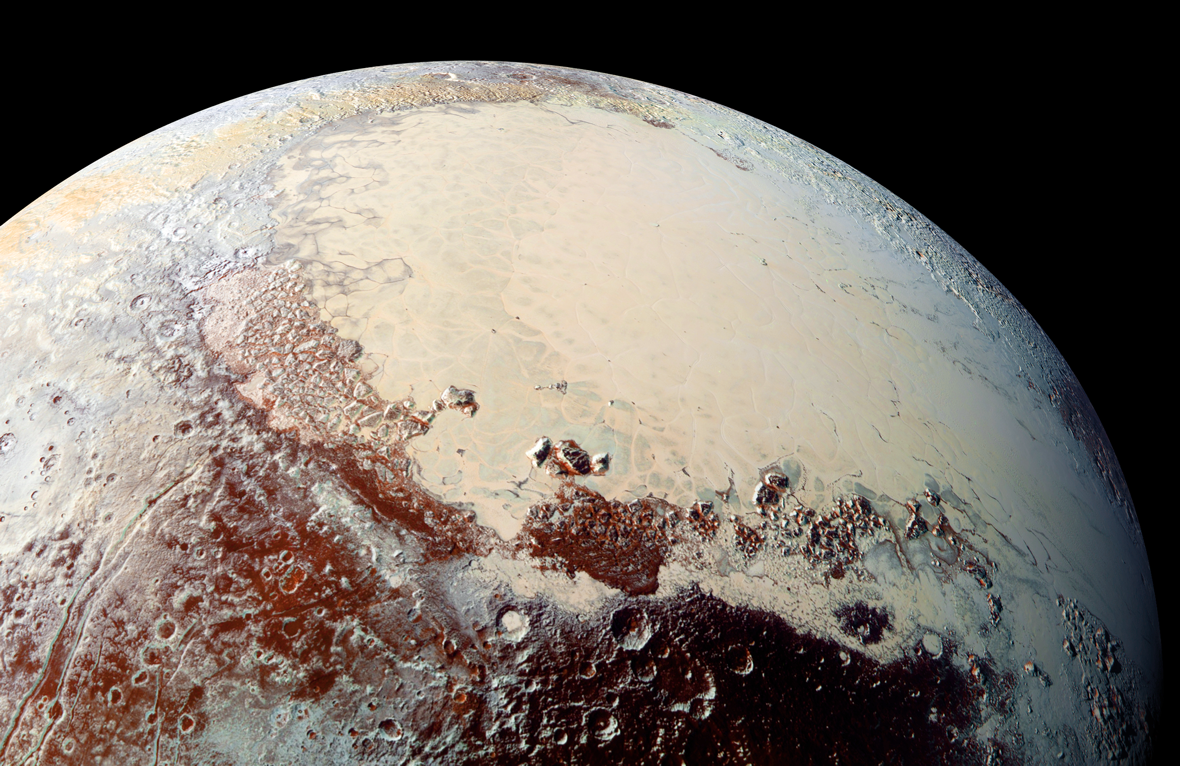
Pluto is a tiny world in the outer fringes of the Solar System; for many decades it was only a mere speck of light in even the best telescopes, with only vague hints of surface features. Then, in July 2015, the New Horizons spacecraft flew past Pluto, the first time ever that humanity would get to see this mysterious place up close—and it did not disappoint. An enormous amount of data has continued to be sent back by New Horizons since the flyby, and now five new papers have been published which provide an in-depth overview of the findings so far about Pluto and its moons. Pluto is an active world, with its own unique geology different from anywhere else in the Solar System.
The new papers have been published in the March 18 issue of the journal Science and cover Pluto’s geology, atmosphere, surface composition, its moons, and interaction with the surrounding space environment. Pluto has been revealed to be a more complex and active world than had largely been anticipated, much to scientists’ delight.
“These five detailed papers completely transform our view of Pluto – revealing the former ‘astronomer’s planet’ to be a real world with diverse and active geology, exotic surface chemistry, a complex atmosphere, puzzling interaction with the Sun and an intriguing system of small moons,” said Alan Stern, New Horizons principal investigator from the Southwest Research Institute (SwRI) in Boulder, Colo.
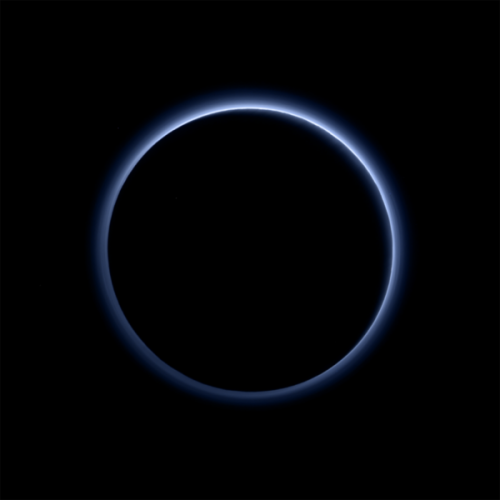
As outlined on the NASA website, the findings by New Horizons include:
- The age-dating of Pluto’s surface through crater counts has revealed that Pluto has been geologically active throughout the past 4 billion years. Further, the surface of Pluto’s informally-named Sputnik Planum, a massive ice plain larger than Texas, is devoid of any detectable craters and estimated to be geologically young—no more than 10 million years old.
- Pluto’s moon Charon has been discovered to have an ancient surface. As an example, the great equatorial expanse of smooth plains on Charon informally named Vulcan Planum (home of the “moated mountains” informally named Kubrick and Clarke Mons) is likely a vast cryovolcanic flow or flows that erupted onto Charon’s surface about 4 billion years ago. These flows are likely related to the freezing of an internal ocean that globally ruptured Charon’s crust.
- The distribution of compositional units on Pluto’s surface—from nitrogen-rich, to methane-rich, to water-rich—has been found to be surprisingly complex, creating puzzles for understanding Pluto’s climate and geologic history. The variations in surface composition on Pluto are unprecedented elsewhere in the outer solar system.
- Pluto’s upper atmospheric temperature has been found to be much colder (by about 70 degrees Fahrenheit) than had been thought from Earth-based studies, with important implications for its atmospheric escape rate. Why the atmosphere is colder is a mystery.
- Composition profiles for numerous important species in Pluto’s atmosphere (including molecular nitrogen, methane, acetylene, ethylene, and ethane) have been measured as a function of altitude for the first time.
- Also for the first time, a plausible mechanism for forming Pluto’s atmospheric haze layers has been found. This mechanism involves the concentration of haze particles by atmospheric buoyancy waves (called “gravity waves” by atmospheric scientists), created by winds blowing over Pluto’s mountainous topography.
- Before the flyby, the presence of Pluto’s four small moons raised concerns about debris hazards in the system. But the Venetia Burney Student Dust Counter only counted a single dust particle within five days of the flyby. This is similar to the density of dust particles in free space in the outer solar system—about 6 particles per cubic mile—showing that the region around Pluto is, in fact, not filled with debris.
- New Horizons’ charged-particle instruments revealed that the interaction region between the solar wind and Pluto’s atmosphere is confined on the dayside of Pluto to within 6 Pluto radii, about 4,500 miles (7,000 kilometers). This is much smaller than expected before the flyby, and is likely due to the reduced atmospheric escape rate found from modeling of ultraviolet atmospheric occultation data.
- The high albedos (reflectiveness) of Pluto’s small satellites—about 50 to 80 percent—are entirely different from the much lower albedos of the small bodies in the general Kuiper Belt population, which range from about 5 to 20 percent. This difference lends further support to the idea that these satellites were not captured from the general Kuiper Belt population, but instead formed by agglomeration in a disk of material produced in the aftermath of the giant collision that created the entire Pluto satellite system.
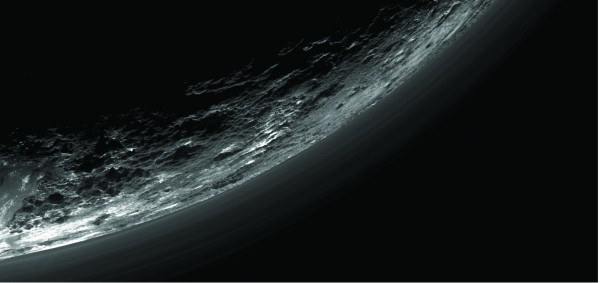
The first paper deals with Pluto’s small moons, of which there are four (the other moon, Charon, is much larger). The smaller moons—Styx, Nix, Kerberos, and Hydra—are irregularly shaped, fast-rotating, and have bright surfaces. All four are highly elongated in shape, with high surface albedos, suggesting that they are coated in water ice. They also all have rotational periods much shorter than their orbital periods, and their rotational poles are clustered nearly orthogonal to the direction of the common rotational poles of Pluto and Charon.
The double-lobed shaped of Kerberos indicates that it, and possibly others, may have formed from the impact of two smaller bodies which fused together. Pluto’s moons are estimated to be at least 4 billion years old.
“These latter two results reinforce the hypothesis that the small moons formed in the aftermath of a collision that produced the Pluto-Charon binary system,” said Hal Weaver, New Horizons project scientist from the Johns Hopkins University Applied Physics Laboratory in Laurel, Md., and lead author of the new small moons paper.
Like most smaller bodies such as asteroids, their color is generally grayish, but there is one impact crater on Nix which has a reddish color. The impacting body may have been reddish or the impact could have excavated reddish material from below Nix’s surface.
The entire Pluto system is thought to have been created by the impact of two Pluto-sized bodies about 4 to 4.5 billion years ago, with the smaller moons forming within the resulting debris disk. The rapid rotation and unusual orbits of these smaller moons make the Pluto system unique in the Solar System.
In the second paper, Pluto’s atmosphere is discussed. It was already known from telescopic observations that Pluto had a thin atmosphere, but New Horizons showed it to be more complex than first thought. Pluto’s atmosphere is primarily nitrogen, but also contains methane, acetylene, ethylene, and ethane. The opacity of nitrogen at high altitudes was lower than expected, indicating a very cold upper atmosphere.
Another unexpected discovery was the haze layers in the atmosphere. The haze is global, extends to high altitudes and is composed of many layers. It is thought to be composed of very fine particles, like tholins, due to its bluish color. The images New Horizons sent back of this bluish haze surrounding Pluto, when backlit by the Sun, are breathtaking.
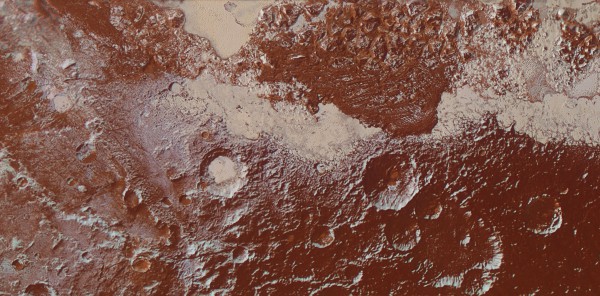
The third paper deals with how Pluto interacts with its surrounding space environment. As measured by the Solar Wind Around Pluto (SWAP) instrument, the solar wind was found to be nearly constant and stronger than expected. The interaction region, between the solar wind and Pluto’s extended atmosphere, is confined to the sunward side of Pluto and is similar in scale to the solar wind interaction with Mars’s escaping atmosphere. This region is smaller than expected, but also unlike any other in the Solar System. As for dust, the Venetia Burney Student Dust Counter, which measures grains with radii larger than 1.4 micrometers, detected one candidate impact in ±5 days around New Horizons’ closest approach.
New Horizons also shed light on how much of Pluto’s atmosphere escapes into space.
“We’ve discovered that pre-New Horizons estimates wildly overestimated the loss of material from Pluto’s atmosphere,” said Fran Bagenal, from the University of Colorado in Boulder, and lead author of the particles and plasma paper. “The thought was that Pluto’s atmosphere was escaping like a comet, but it is actually escaping at a rate much more like Earth’s atmosphere.”
“We’ve also discovered that methane, rather than nitrogen, is Pluto’s primary escaping gas. This is pretty surprising, since near Pluto’s surface the atmosphere is more than 99 percent nitrogen,” added Randy Gladstone of SwRI.
The surface compositions of Pluto and its largest moon Charon are the subject of the fourth paper, and again, surprises were to be found. While there was already evidence for ice on Pluto, data from New Horizons showed the surface composition of both Pluto and Charon to be more varied than expected. While part of Pluto is ancient and crater-covered with a coating of tholins, other regions are smooth, icy plains, completely free of craters. This indicates that they are much younger geologically, and the ice is somehow being constantly replenished. The vast icy plains, such as Sputnik Planum, are composed of nitrogen ice, while elsewhere, methane, carbon monoxide, and water ices can also be found. The ice in the plains is thought to be replenished by ice coming up to the surface from below, through convection, and there are also nitrogen ice glaciers feeding into the plains, which are then bordered by rugged mountains of solid water solid. These ices can also sublimate and condense in a regular seasonal cycle. At Pluto’s extremely cold temperatures, water ice is as hard as rock, while nitrogen ice is softer and can flow just like glaciers on Earth.
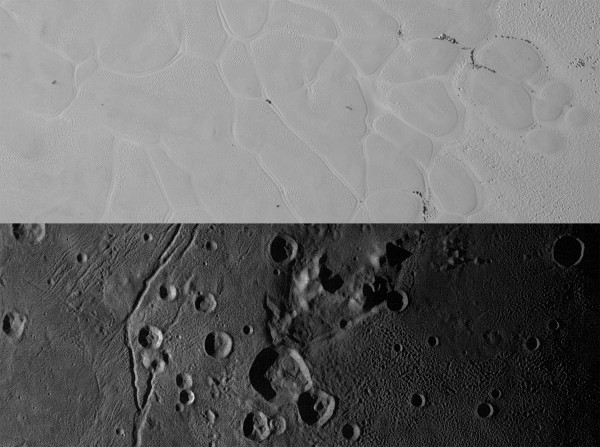
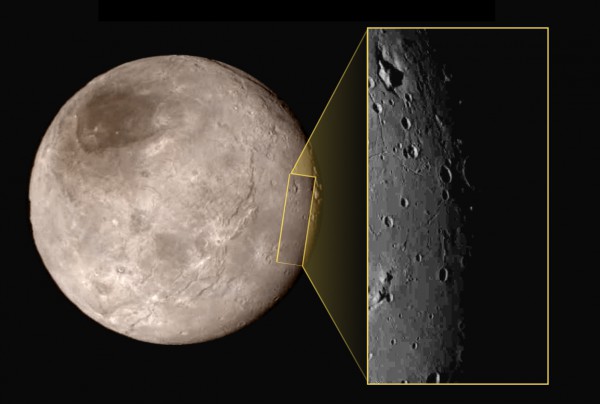
“We see variations in the distribution of Pluto’s volatile ices that point to fascinating cycles of evaporation and condensation,” said Will Grundy of the Lowell Observatory, Flagstaff, lead author of the composition paper. “These cycles are a lot richer than those on Earth, where there’s really only one material that condenses and evaporates – water. On Pluto, there are at least three materials, and while they interact in ways we don’t yet fully understand, we definitely see their effects all across Pluto’s surface.”
Charon also features a unique reddish-colorerd “cap” of tholins at its north pole. Not only is the Pluto system more active than previously thought, it is also more colorful. In contrast with Pluto, Charon’s surface is rich in water ice, as it is not massive enough to hold on to the more volatile ices.
As also recently reported on AmericaSpace, there is methane “snow” on some of Pluto’s mountain peaks. Again, visually similar to Earth, but with a very different composition.
According to John Stansberry, a New Horizons science team member from the Space Telescope Science Institute in Baltimore, Md., “That this material coats only the upper slopes of the peaks suggests methane ice may act like water in Earth’s atmosphere, condensing as frost at high altitude.”
The final fifth paper covers the geology of Pluto and Charon. Active geology was only anticipated at a small scale, if at all, given Pluto’s small size and remote distance from the Sun. This geology involves the ices, glaciers, and mountains, as well as possible cryovolcanoes (ice volcanoes) and subsurface ocean.
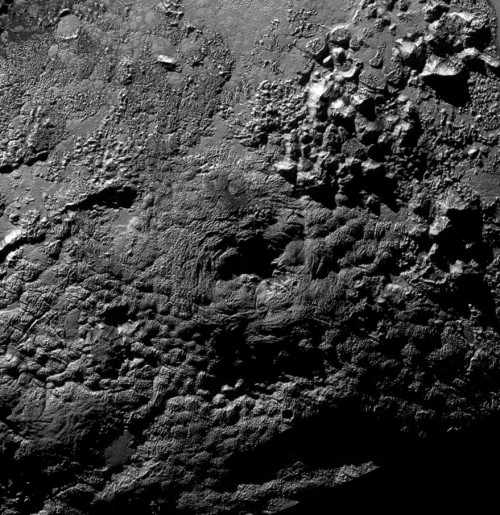
The glaciers are very reminiscent of ones on Earth, except that the composition is different, with nitrogen ice instead of water ice. The mountains bordering the glaciers and ice plains, however, are solid water ice, instead of rock, and there are “icebergs” of water ice floating in the nitrogen ice plains.
There is also a lot of water ice in Pluto’s crust, and also now evidence that below the crust, there is likely a water ocean. An ocean? On Pluto? Although not confirmed yet, evidence is pointing to just that, seemingly similar to the subsurface oceans of moons like Europa, Enceladus, Titan, Ganymede, and possibly others. Geological evidence on the surface suggests that it is a late ocean, meaning that it could still be liquid today, or perhaps partially frozen. The ice crust above it is very cold and strong. So how could an ocean remain liquid on Pluto? Internal heating would be required, from the natural decay of radioactive elements in rocks, as well as a lot of ammonia in the water.
As Stern mentioned in Discovery News, “We now have half a dozen worlds, like (Saturn’s moon) Enceladus, (Jupiter’s moons) Europa and Ganymede, and now Pluto, that seem to have oceans in their interiors.”
As William McKinnon at Washington University in St. Louis also noted in DN: “All we can say is that we think that Pluto has an ocean and we think that this ocean has survived to the present day. It’s the kind of ocean that is deep inside the interior of Pluto, in total darkness. But, it would lie between a floating water ice shell and the rocky interior, so it would be in contact with rock. There would be a modest amount of heat leaking out.”
As for the possibility of some kind of life in that ocean, he added, “You certainly couldn’t rule it out, but anything about life on Pluto is simply speculation.”
Stern echoed that sentiment with, “Anytime you have liquid water, the astrobiologists get interested in that place. That’s as far as I’m willing to go.”
Indeed, the idea of life on Pluto is something that few if any scientists would have considered a few years ago. If there is a subsurface ocean, it will still require a follow-up mission to further explore this possibility.
Ice volcanoes have also been tentatively identified on Pluto, where ice would be released to the surface instead of lava. Wright Mons, the primary candidate, is 1.8-2.5 miles (3-4 km) high and about 93 miles (150 km) across. Piccard Mons is similar, but about 3.7 miles (6 km) high and 139 miles (225 km) across. Faults, troughs, and scarps also indicate tectonic activity on Pluto, as well as providing evidence for a thick water-ice lithosphere—yet another analogy with Earth.
Charon also features ridges, troughs, and canyons, and its northern hemisphere is more cratered and rugged than its southern hemisphere. The reddish “cap” at the north pole is thought to be composed of tholins. One of the most unusual features seen by New Horizons was the “mountain in a moat,” where a tall block of material is imbedded within a shallow moat-like depression. There is also evidence for an interior ocean in Charon as well, but it is thought to be completely frozen.
Pluto and Charon are also sometimes referred to as a “binary planet,” since they both orbit around a common center of mass. This is also another unique aspect of the Pluto system.
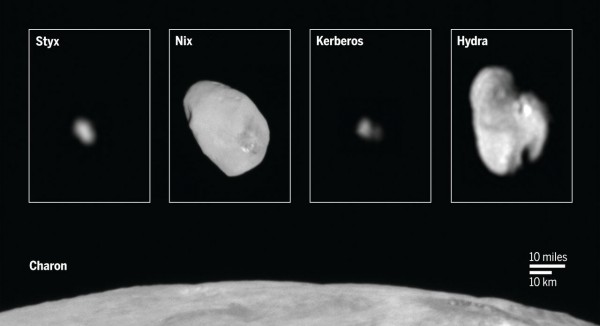
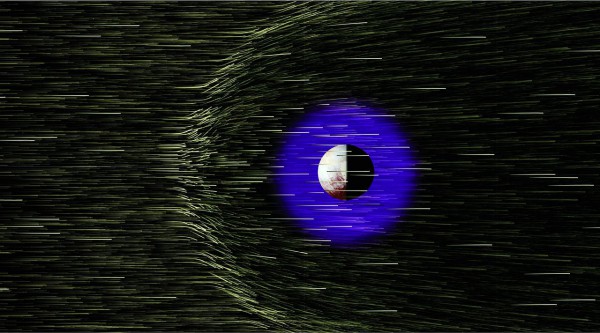
Pluto is more active and dynamic than previously thought possible, and may also provide a hint of what other objects in the Kuiper Belt might be like.
“Observing Pluto and Charon up close has caused us to completely reassess thinking on what sort of geological activity can be sustained on isolated planetary bodies in this distant region of the Solar System, worlds that formerly had been thought to be relics little changed since the Kuiper Belt’s formation,” said Jeff Moore, lead author of the geology paper from NASA’s Ames Research Center, Moffett Field, Calif.
There is a lot more detailed information in the new papers themselves, so be sure to take a look. While these five new papers cover many new discoveries by New Horizons, there is still a lot more to come. Data from the spacecraft is still being sent back, and will be for several more months. Pluto has begun to reveal its secrets, but it is by no means finished yet.
“This is why we explore,” said Curt Niebur, New Horizons program scientist at NASA Headquarters in Washington. “The many discoveries from New Horizons represent the best of humankind and inspire us to continue the journey of exploration to the solar system and beyond.”
Pluto will also be in the news again next week, as part of a press briefing on March 22, during the 47th Lunar and Planetary Science Conference in The Woodlands, Texas.
Follow our New Horizons mission page for regular updates.
Be sure to “Like” AmericaSpace on Facebook and follow us on Twitter: @AmericaSpace
Missions » New Horizons »





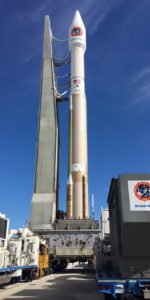
I enjoy reading your atricle!!! Thanks a lot!!
I am so interested in your articles..congratulations Reading your articles is so pleasant for me..Thank you
Ι read it with pleasur. Really interesting article!!